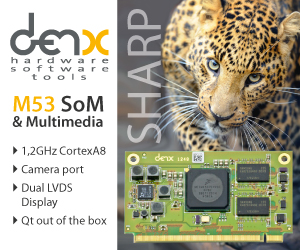Wind River Linux adds 64-bit ARM, adopts Yocto 1.5
Oct 24, 2013 | Eric Brown Wind River announced Wind River Linux 6, featuring Yocto Project 1.5 Linux kernel and toolchain, and expanded multi-architecture hardware support including 64-bit ARMv8. Wind River also announced a faster new Yocto-compatible version of its carrier-grade Wind River Open Virtualization software.
Wind River announced Wind River Linux 6, featuring Yocto Project 1.5 Linux kernel and toolchain, and expanded multi-architecture hardware support including 64-bit ARMv8. Wind River also announced a faster new Yocto-compatible version of its carrier-grade Wind River Open Virtualization software.
Wind River made its Wind River Linux 6 and Wind River Open Virtualization announcements at the Linux Foundation’s Embedded Linux Conference Europe (ELCE), which is being held this week in Edinburgh, Scotland. In version 6, Wind River Linux furthers its tight integration with the Linux Foundation’s Yocto Project. The Intel subsidiary also continued its tradition of cross-platform processor support, expanding hardware support for the latest ARM, Intel, MIPS, and Power architectures.
Wind River did not offer many details on the expanded support in its industry leading commercial embedded Linux distribution except to say it now supports ARM 64-bit processing. This would suggest support for upcoming ARMv8 processors based on ARM’s Cortex-A57 and Cortex-A53 IP. Apple just released one of the first 64-bit ARM chips in the A7 chip fueling the new iPhone 5S, but many more Android- and Linux-targeted designs are on the way in 2014 and 2015. Samsung and Nvidia are known to be prepping 64-bit ARM SoCs for the mobile and embedded space, where expanded memory access should improve the performance of games and video-intensive applications. Networking and server oriented 64-bit ARM SoCs include AppliedMicro’s X Gene, Cavium’s Project Thunder, and Broadcom’s newly announced, still unnamed 64-bit platform.
It’s unclear what other new chip designs have been embraced. At this point, Wind River says it offers optimized BSPs for Freescale, Intel, LSI, Texas Instruments, and Xilinx platforms. In March, Wind River announced support for Intel’s 3rd Generation “Ivy Bridge” Core processors in Wind River Linux 5. Presumably, the company would publicize any support for Intel’s 4th Generation “Haswell” Core processors or the new Silvermont-based Atom system-on-chips (SoCs).
Last week, Wind River announced Wind River Linux support for Cavium’s MIPS64-based Octeon III SoCs. It will likely add support for Imagination Technologies’s new MIPS Series5 Warrior-P processor before too long.
Wind River did not mention its support for Intel’s Linux-ready, embedded Quark processor, designed for low-power Internet of Things (IoT) applications. Wind River is said to have provided an embedded OS to Dalkin for a Quark-based HVAC product, and the company is working on IoT gateway stacks using the Quark, as well as the embedded-oriented, Bay Trail-I (“Silvermont”) Atom E3800.
In addition, Wind River offered the following quote as part of the Wind River Linux 6 announcement: “Wind River helps developers rapidly implement highly interoperable Linux projects for a variety of platforms that will be ready to tackle the opportunities and challenges arising from IoT,” stated Dinyar Dastoor, vice president of product management at Wind River.
Yocto Project 1.5 compatibility
Wind River Linux first started pushing its Yocto Project compatibility with Wind River Linux 5, leading a general trend among commercial embedded Linux players like MontaVista, Mentor Graphics, and Enea toward greater compliance with the open source embedded code project. In March when the company announced the registration of its Wind River Linux Carrier Grade (CG) profile for compliance with the Linux Foundation’s Carrier Grade Linux (CGL) v5.0 requirements, it was claimed to be the first Yocto Compatible CGL-registered Linux distribution. Wind River is a founding member of the Intel-backed Yocto Project, as well as a Gold member of the advisory board.

Wind River Linux product overview
(click image to enlarge)
Founded in 2010, the Yocto Project is a collaborative effort among manufacturers and operating systems vendors “to bring some order to the chaos of embedded Linux development,” according to the open source project. Specifically, the project provides “templates, tools, and methods to help developers create custom Linux-based systems for embedded products regardless of their hardware architecture.”
Wind River Linux now uses the latest Linux kernel 3.10, GNU 4.8 toolchain, and the BitBake build system and user space from the OpenEmbedded (OE) based Yocto Project 1.5 “Dora”, which was released on Oct. 18. The new release adds major performance improvements, more than 180 BitBake recipe upgrades, new x86 reference BSPs, and over 400 repaired bugs.
Wind River Linux 6 works with Yocto Project compatible BSPs, software, and middleware, says the company. Yet, Wind River continues to add its own commercial-grade Linux offerings, including integrated development tools like the Wind River Workbench IDE and related open source integration modules and add-ons like the Wind River Simics simulation platform.
Other touted benefits of Wind River Linux 6 include commercial off-the-shelf (COTS) run-times with pre-configured, footprint, latency, and power management profiles for jump-starting device development. The platform also ships with regular bug fixes, based on “innovative patch management technology,” and risk mitigation services for clarifying open source licensing and export control compliance. All this is backed up by worldwide support and maintenance, as well as professional services, says the company.
Wind River Open Virtualization gains update
Wind River also announced an update for its Wind River Open Virtualization Profile, billed as an “ultra-high performance, open source, KVM-based Type 2 hypervisor.” Wind River announced Open Virtualization in June, touting the product for its CPU isolation and under 3-second latency, with promises of support for future network functions virtualization (NFV) standards.

Wind River Open Virtualization Profile architecture
(click image to enlarge)
The Yocto Project–based software combines the open source Kernel-based Virtual Machine (KVM) hypervisor with a hardened, real-time Linux kernel based on Wind River Linux. The profile offers a real-time, deterministic KVM solution, complete with virtual machine management, that provides “near-native hardware performance to meet the rising demand for hardware consolidation, scalability, and time-to-market challenges across industries,” says the company.
The new version offers performance and live migration enhancements, says Wind River. Specific enhancements are said to include:
- Improved throughput and latency speeds, including an 18 percent reduction in maximum interrupt latency
- Improved virtual switching throughput with integrated Intel DPDK vSwitch, offering a 450 percent increase in virtual switching speeds over standard Open vSwitch
- Enhanced live migration capabilities, including intra-CPU migration to intra-node migration and intra-virtual machine switching
- oVirt-powered live migration console, including support for guest OS migration
- Security enhancements based on SELinux
- Additional hardware support for the latest Intel architectures
- Expanded guest OS support
“As new devices continue to connect to an increasingly strained network, next-generation telecom equipment must scale to support technologies such as cloud and NFV in order to meet rising data traffic demands and address new service deployment challenges,” stated Davide Ricci, product line manager for open source platforms at Wind River.
Further information
Wind River Linux 6 and the updated Wind River Open Virtualization appear to be available now. More information may be found at the Wind River Linux and Wind River Open Virtualization product pages respectively.















